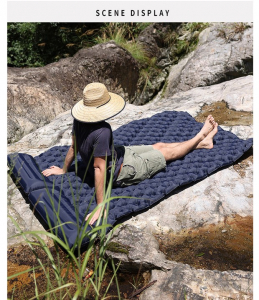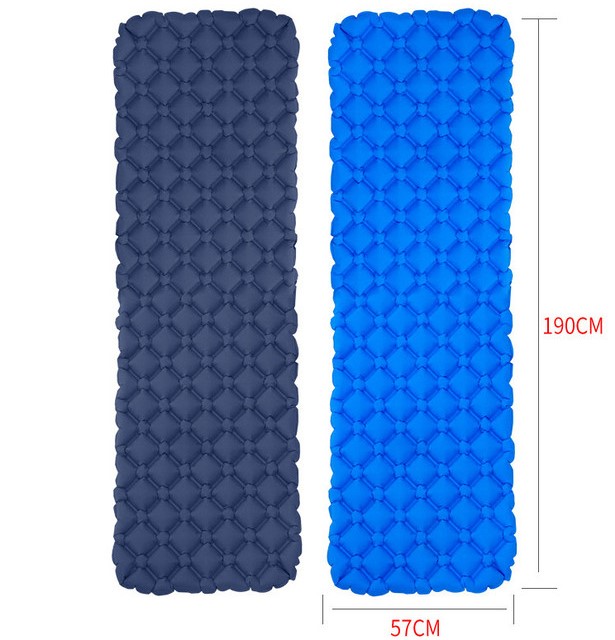News Center+ 查看更多
News Center
+ 查看更多
Sleep Well, Play Well: A Comprehensive Analysis and Recommendation of Camping Sleeping Mats+ 查看更多
Sleep Well, Play Well: A Comprehensive Analysis and Recommendation of Camping Sleeping Mats
+ 查看更多
Date:2023-09-14
Introduction
A good night's sleep is crucial for an enjoyable camping experience. The right camping sleeping mat can significantly impact your comfort and restfulness during outdoor adventures. This comprehensive analysis will delve into the world of camping sleeping mats, examining their features, materials, insulation properties, and overall comfort levels. By the end of this article, you will have all the information you need to decide when choosing the perfect camping sleeping mat for your needs.Types of Camping Sleeping Mats
Camping sleeping mats come in various types, each with its own unique benefits and considerations:- Air Mattresses: These mattresses offer adjustable firmness and optimal comfort. They are typically made from durable materials like PVC or nylon and can be inflated using a manual or electric pump.
- Self-Inflating Mats: Combining convenience with insulation, self-inflating mats feature foam cores that expand when the valve is opened, drawing in air to inflate the mat.
- Foam Pads: Lightweight and compact, foam pads provide decent insulation while acting as a barrier between you and the ground.
- Insulated Mats: Designed for cold weather camping, insulated mats incorporate materials like down or synthetic fibres to enhance warmth retention and prevent heat loss to the ground.
- Hybrid Mats: These mats combine the best features of different types, offering a balance between comfort, insulation, and packability.
Factors to Consider When Choosing a Camping Sleeping Mat
To ensure you find the perfect camping sleeping mat, take the following factors into consideration:- Weight and Packability: If you plan on carrying the mat during hikes or backpacking trips, choose a lightweight and easily packable option.
- Insulation and R-Value: The insulation properties of a mat are measured by its R-value. Consider the expected temperature range during your camping trips and choose a mat with an appropriate R-value for the conditions.
- Comfort and Support: Look for mats that offer sufficient cushioning and support, taking into account factors such as thickness, padding, and body contouring features.
- Durability and Longevity: Choose a camping sleeping mat made from durable materials that can withstand rough terrains and frequent use. Look for reinforced seams, puncture-resistant fabrics, and reliable valve systems.
- Size and Dimensions: Consider your height and personal space preferences when selecting the size and dimensions of the mat. Ensure it provides enough room for comfortable movement during sleep.
- Inflation and Deflation Methods: Evaluate the ease of inflation and deflation. Some mats require manual pumping, while others feature built-in pumps or self-inflating mechanisms for added convenience.
Materials Used in Camping Sleeping Mats
The choice of materials used in camping sleeping mats affects their durability, comfort, and insulation properties:- Outer Shell Materials: Nylon and polyester are commonly used for the outer shell due to their durability, water resistance, and ability to withstand wear and tear.
- Foam Materials: Polyurethane foam is widely used in camping mats for its lightweight nature, excellent insulation properties, and cushioning capabilities.
- Insulation Materials: Insulated mats may use down or synthetic insulation for enhanced warmth retention. Down offers superior insulation but requires careful maintenance.
- Coatings and Treatments: Coatings such as thermoplastic polyurethane (TPU) or polyvinyl chloride (PVC) are often applied to the surface of camping mats to provide water resistance, durability, and protection from punctures.
Insulation Properties and Temperature Ratings
Understanding insulation properties and temperature ratings is essential when choosing a suitable camping sleeping mat:- R-Value: The R-value measures the insulation capability of a material. Higher R-values indicate better insulation. Consider the expected temperatures during your camping trips and choose a mat with an appropriate R-value.
- Seasonal Use and Temperature Ratings: Different mats have temperature ratings for specific seasons or climates. Ensure you choose a mat with a temperature rating suitable for your camping environment.
- Cold Weather Considerations: For cold weather camping, opt for mats with higher R-values and excellent insulation materials to prevent heat loss to the ground and maintain warmth throughout the night.
- Inflation Techniques for Insulation Efficiency: Properly inflating your camping sleeping mat is crucial for maximizing its insulation properties. Follow the manufacturer's guidelines to ensure an effective barrier against the cold ground.
Comfort Features and Design Considerations
To enhance your comfort while camping, consider the following features and design considerations:- Thickness and Padding: Thicker mats provide more cushioning and support, especially for side sleepers or individuals with sensitive pressure points.
- Surface Texture and Grip: Look for mats with a textured surface or non-slip grip to prevent sliding during sleep, especially on uneven or sloping terrains.
- Noise Reduction and Anti-Slip Properties: Some mats are designed to minimize noise and offer anti-slip properties, ensuring a peaceful night's sleep and preventing you from sliding off the mat during the night.
- Body Contouring and Support: Consider mats that contour to your body shape, providing optimal support and relieving pressure points for a more comfortable sleep.
- Breathability and Moisture Wicking: Choose mats with breathable materials or moisture-wicking properties to prevent sweat buildup and keep you dry throughout the night.
- Easy Maintenance and Cleaning: Look for mats that are easy to clean and maintain, as regular cleaning helps prolong their lifespan and keeps them hygienic for future use.
Tips for Choosing the Right Camping Sleeping Mat
To make an informed decision when selecting a camping sleeping mat, here are some additional tips:- Read Reviews and Seek Recommendations: Take the time to read reviews from other campers and seek recommendations from experienced outdoor enthusiasts. Their insights can provide valuable information and help narrow down your options.
- Test it Out: If possible, try out different mats in-store or borrow from friends before making a purchase. Testing the comfort and support firsthand will give you a better idea of what works best for you.
- Consider Your Sleeping Style: Different sleeping styles (back, side, stomach) require varying levels of support and cushioning. Consider your preferred sleeping style when choosing a mat to ensure maximum comfort.
- Check the Warranty: Look for mats that come with a warranty, as this demonstrates the manufacturer's confidence in their product's durability and quality.
Conclusion
A good camping sleeping mat is an investment in your comfort and enjoyment during outdoor adventures. By considering factors such as type, insulation properties, materials, and comfort features, you can choose a mat that meets your specific needs. Whether you're backpacking through rugged terrains or car camping with family and friends, a well-chosen camping sleeping mat will ensure you sleep well and wake up ready to play all day. Happy camping!



